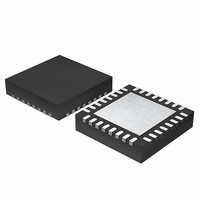EFM32G200F64 Energy Micro, EFM32G200F64 Datasheet - Page 50

EFM32G200F64
Manufacturer Part Number
EFM32G200F64
Description
MCU 32BIT 64KB FLASH 32-QFN
Manufacturer
Energy Micro
Series
Geckor
Datasheets
1.EFM32G200F16.pdf
(63 pages)
2.EFM32G200F16.pdf
(10 pages)
3.EFM32G200F16.pdf
(463 pages)
4.EFM32G200F16.pdf
(136 pages)
Specifications of EFM32G200F64
Core Processor
ARM® Cortex-M3™
Core Size
32-Bit
Speed
32MHz
Connectivity
EBI/EMI, I²C, IrDA, SmartCard, SPI, UART/USART
Peripherals
Brown-out Detect/Reset, DMA, POR, PWM, WDT
Number Of I /o
24
Program Memory Size
64KB (64K x 8)
Program Memory Type
FLASH
Ram Size
16K x 8
Voltage - Supply (vcc/vdd)
1.8 V ~ 3.8 V
Data Converters
A/D 4x12b, D/A 1x12b
Oscillator Type
External
Operating Temperature
-40°C ~ 85°C
Package / Case
32-VQFN Exposed Pad
Processor Series
EFM32G200
Core
ARM Cortex-M3
Data Bus Width
32 bit
Data Ram Size
16 KB
Interface Type
I2C, UART
Maximum Clock Frequency
32 MHz
Number Of Programmable I/os
24
Number Of Timers
2
Operating Supply Voltage
1.8 V to 3.8 V
Maximum Operating Temperature
+ 85 C
Mounting Style
SMD/SMT
Minimum Operating Temperature
- 40 C
Lead Free Status / RoHS Status
Lead free / RoHS Compliant
Eeprom Size
-
Lead Free Status / Rohs Status
Details
Available stocks
Company
Part Number
Manufacturer
Quantity
Price
- EFM32G200F16 PDF datasheet
- EFM32G200F16 PDF datasheet #2
- EFM32G200F16 PDF datasheet #3
- EFM32G200F16 PDF datasheet #4
- Current page: 50 of 463
- Download datasheet (8Mb)
8.4.2.4 Error signaling
8.4.3 Channel control data structure
2010-09-06 - d0001_Rev1.00
Primary, copy A
Task A
After the peripheral issues a new request and it has the highest priority then the process continues with:
Primary, copy B
Task B
After the peripheral issues a new request and it has the highest priority then the process continues with:
Primary, copy C
Task C
After the peripheral issues a new request and it has the highest priority then the process continues with:
Primary, copy D
Task D
If the controller detects an ERROR response on the AHB-Lite master interface, it:
• disables the channel that corresponds to the ERROR
• sets dma_err HIGH.
After the host processor detects that dma_err is HIGH, it must check which channel was active when
the ERROR occurred. It can do this by:
1. Reading the DMA_CHENS register to create a list of disabled channels.
When a channel asserts dma_done[ ] then the controller disables the channel. The program running
on the host processor must always keep a record of which channels have recently asserted their
dma_done[ ] outputs.
2. It must compare the disabled channels list from step 1 (p. 50) , with the record of the channels that
You must provide an area of system memory to contain the channel control data structure. This system
memory must:
have recently set their dma_done[ ] outputs. The channel with no record of dma_done[C] being
set is the channel that the ERROR occurred on.
1. After receiving a request, the controller performs four DMA transfers. These
2. The controller performs task A.
3. After the controller completes the task it enters the arbitration process.
4. The controller performs four DMA transfers. These transfers write the alternate
5. The controller performs task B. To enable the controller to complete the task,
6. After the controller completes the task it enters the arbitration process.
7. The controller performs four DMA transfers. These transfers write the alternate
8. The controller performs task C.
9. After the controller completes the task it enters the arbitration process.
10. T he controller performs four DMA transfers. These transfers write the alternate
11. T he controller sets the cycle_ctrl bits of the primary data structure to b000, to
12. T he controller performs task D using a basic cycle.
13. T he controller sets dma_done[C] HIGH for one HFCORECLK cycle and enters
transfers write the alternate data structure for task A.
data structure for task B.
the peripheral must issue a further three requests.
data structure for task C.
data structure for task D.
indicate that this data structure is now invalid.
the arbitration process.
...the world's most energy friendly microcontrollers
50
www.energymicro.com
Related parts for EFM32G200F64
Image
Part Number
Description
Manufacturer
Datasheet
Request
R

Part Number:
Description:
KIT STARTER EFM32 GECKO
Manufacturer:
Energy Micro
Datasheet:

Part Number:
Description:
KIT DEV EFM32 GECKO LCD SUPPORT
Manufacturer:
Energy Micro
Datasheet:

Part Number:
Description:
BOARD PROTOTYPING FOR EFM32
Manufacturer:
Energy Micro
Datasheet:

Part Number:
Description:
KIT DEVELOPMENT EFM32 GECKO
Manufacturer:
Energy Micro
Datasheet:

Part Number:
Description:
MCU, MPU & DSP Development Tools TG840 Sample Kit
Manufacturer:
Energy Micro
Datasheet:

Part Number:
Description:
MCU, MPU & DSP Development Tools TG Starter Kit
Manufacturer:
Energy Micro
Datasheet:

Part Number:
Description:
MCU, MPU & DSP Development Tools TG108 Sample Kit
Manufacturer:
Energy Micro

Part Number:
Description:
MCU, MPU & DSP Development Tools TG210 Sample Kit
Manufacturer:
Energy Micro
Datasheet:

Part Number:
Description:
MCU, MPU & DSP Development Tools TG822 Sample Kit
Manufacturer:
Energy Micro
Datasheet:

Part Number:
Description:
MCU, MPU & DSP Development Tools TG230 Sample Kit
Manufacturer:
Energy Micro

Part Number:
Description:
SAMPLE KIT (SMALL BOX - CONTAINING 2 DEVICES)
Manufacturer:
Energy Micro

Part Number:
Description:
SAMPLE KIT (SMALL BOX - CONTAINING 2 DEVICES)
Manufacturer:
Energy Micro











